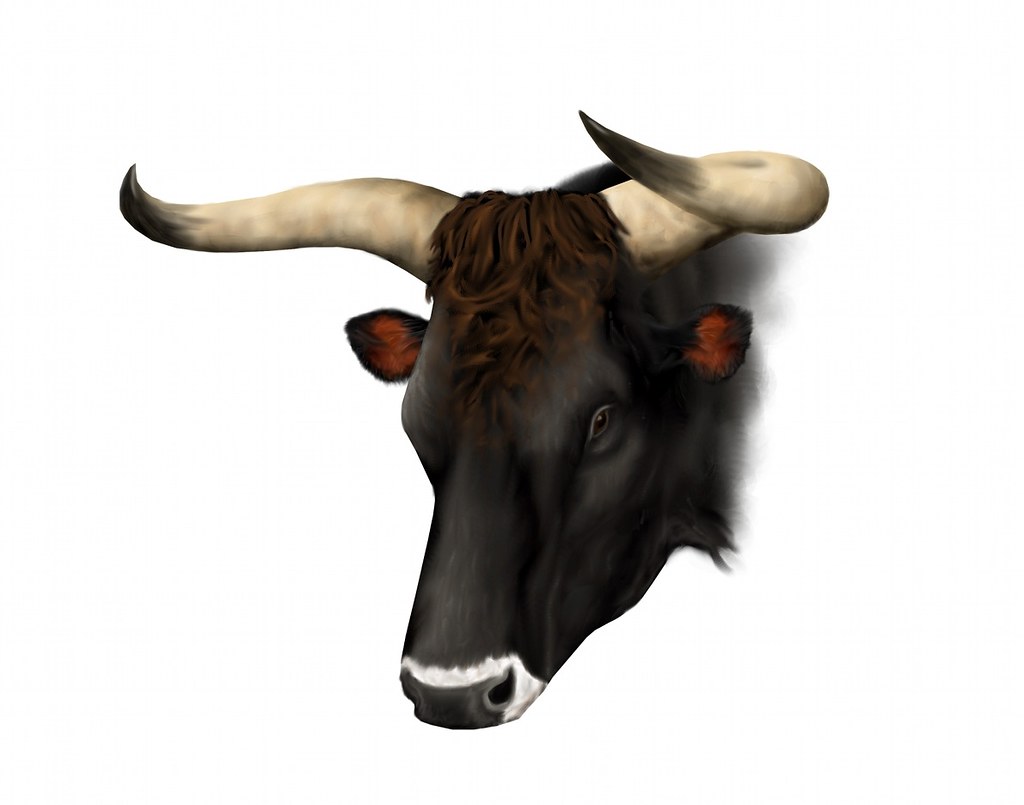What's so charming about the aurochs?
I have some material prepared for several posts, just not the time yet to finish them. Therefore, I ask for patience – more is to come soon. In the meantime, a more “philosophical” post.
Some animals do have some sort of charisma. Dinosaurs are charismatic, for example – there are millions of dinosaur fans on this world, and some of them have made it their profession. Big cats also capture the fascination of people, otherwise they would not be the focus of wallpapers or there would be no cars or weapons named after them. The aurochs has a kind of charisma too. There have been scientists, artists and cattle breeders obsessed with this animal, and there are still dozens, probably hundred or perhaps even thousands of people that are interested in this bovine, many of them in a very passionate way (and there is reason to believe that the numbers are rising). So what makes this animal that fascinating?
If the aurochs was not extinct, we would probably regard them as ordinary bovines. Surely, living aurochs would be an impressive sight – their size, their horns, their athletic energetic body. And some zoo visitors might even notice that their sexes have totally different colours, which is quite unusual for most mammals. But other wild bovines are very impressive too, and people do not usually go nuts about them.
I think it is mostly the fact that the aurochs is extinct that makes it that interesting in the first place. Particularly that it was evidently driven to extinction by man in recent times, and did not die out for unknown reasons some millennia ago. And it would be still around without anthropogenic influence. This makes the aurochs a lot more graspable. There is similar interest in other animals driven to extinction by man, such as the thylacine or the dodo (which, in any case, were both unique animals). It is the mere fact that we could still see these animals in flesh, living and breathing, if the actions of our species had been less consuming and destructive that provokes interest and emotions.
Furthermore, there is something that makes the aurochs more graspable than most other extinct animals – it has living descendants that happen to be one of our most familiar livestock, cattle. But everything in the aurochs was more spectacular, wilder – its body was larger, its horns were larger, they were athletically built and powerful, of an eye-catching contrast-rich colouration and their frizzy forelocks gave them a wild and fierce look (according to people who saw them in live). And because of the fact that they are extinct they get (wrongly) associated with mammoths and the other spectacular glacial fauna (they were, however, a key part of the not less spectacular interglacial fauna). So the aurochs is on the one side an animal we can relate to, but on the other side has an aura of being wild, untamed, strong and ancient.
The fact that the aurochs has living descendants that all preserve its trait to a greater or lesser extent is what makes it really exciting. Isn’t it fascinating to see that this one cow might have horns of a shape like the wild-type that disappeared, while the other cow might be coloured exactly like a wild cow, and isn’t tempting to try unifying all those preserved optical wild-type traits in one strain? Fortunately a number of projects try exactly that. The concept is fascinating: picking the most suited breeds, crossbreeding them and trying to achieve something that optically resembles the aurochs as far as possible. And since all those suited breeds are hardy, healthy and robust enough to survive on their own, and because cattle – as direct descendants of the aurochs – probably work ecologically in a very similar if not identical manner, such a result would not only look like the aurochs but also ecologically fill its niche and probably also behave very similar. The next best thing to cloning, and exciting to watch. It is exciting to see what has been achieved so far, to watch it progressing and to think on how it might be improved. So, here we do not only have the chance of creating a close approximation to an extinct animal with living animals in flesh and blood, and not just with pen and paper as I used to do it for years, but also to fill an ecological niche that has been made vacant by human actions.
It was exactly that chance to fill a vacant ecological with animals that resemble an extinct form that got me that much into the aurochs in 2011. Now I am one of the many aurochs enthusiasts, and it is a surprisingly rich topic – it not only includes palaeontology and zooarchaeology, but also ecology, genetics and animal breeding. I am concerning myself with that topic since almost exactly six years now, and it simply does not get boring – quite the contrary, it keeps being exciting.



Comments
Post a Comment